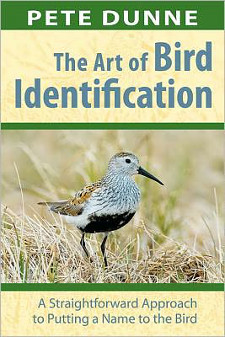Reviewed by Grant McCreary on October 14th, 2012.
Have you ever been birding with someone whose ability to make quick, accurate identifications left you slack jawed? In many cases, bird identification can seem more akin to magic than science. I know I felt that way when I first started out (and still do in the presence of some). But, of course, it isn’t magic but rather a skill that can be mastered. Still, there’s more to it than simply memorizing field marks and range maps. Pete Dunne brings his considerable writing skill to bear in explaining all this to beginners in the aptly named The Art of Bird Identification: A Straightforward Approach to Putting a Name to the Bird.
On the very first page of the first chapter, Dunne neatly sums up “the trick” of birding: “if you don’t know what you are looking at, then you need to know what to look for and how to look for it”. Dunne takes the reader step-by-step through this process. He compares identifying a bird to finding an assigned seat in a stadium. To get to your seat, you first have to make your way to the stadium, then to the correct section, then row, and finally your seat. To successfully pin a name on a bird, you first narrow the choices by habitat (stadium), then subgroup/order (section), family (row), and ultimately to species (seat).
Since habitat and taxonomical sorting play such a large role in this identification framework, Dunne spends a good deal of time describing them. A list of major North American habitats and the bird groups they support only takes a few pages. But fully a quarter of the book is devoted to a description of each North American bird group and common representatives. At first, I thought this excessive. But then I realized how incredibly helpful this section would be to someone just getting into birds. Dunne has a knack for distilling the vast volume of information available into just what is relevant at the moment. One of the best things beginners could do to jumpstart their identification skills would be to read each of these descriptions and then turn to their field guide and survey the group and try to match Dunne’s description to the illustrations.
After getting to the family level, you still have one, final step. And chapter four of The Art of Bird Identification is the best tutorial for beginners on narrowing identification down to the species level that I’ve ever read. That’s not to say that this book treats specific identification challenges, such as flycatchers or gulls. Rather, it lays down a foundation on which to base identifications. Dunne gives plenty of great, practical advice such as reading everything you can find about a bird – after you’ve seen it. That’s one thing that really helped me as a novice, but I don’t think I had ever seen it in print before now.
Dunne goes on to cover such things as judging size, using probability, and (prominently) learning bird sounds. He does all this in his wonderful, trademark style. He doesn’t simply give a list of do’s and don’ts, but mixes it in with a narrative of personal stories illustrating the concepts he is trying to impart. I don’t think Dunne is capable of writing a boring sentence, which makes The Art of Bird Identification a fun, quick read, even for those who have long since advanced beyond beginner rank.
This book is illustrated with some nice, large, color photographs of birds, as well as a few whimsical drawings that play off of something mentioned in the text.
Recommendation
There are plenty of books on this subject, but The Art of Bird Identification is the best out there for beginning birders. Those with more experience will get much less out of it, but reading anything written by Pete Dunne is time well spent, no matter your skill level.
Dunne’s previous The Art of Bird Finding makes a good companion to this volume. Also, once you’ve become familiar with the identification concepts here and you want to continue growing in the art of bird identification, then I’d recommend Kenn Kaufman’s Field Guide to Advanced Birding and Derek Lovitch’s How to Be a Better Birder. If Dunne’s book is the foundation, then to continue the metaphor, these two are the framework for better identification skills.
Disclosure: I get a small commission for purchases made through links in this post.
Disclosure: The item reviewed here was a complementary review copy provided by the publisher. But the opinion expressed here is my own, it has not been influenced in any way.





[…] At The Birder’s Library, a nice review of a Pete Dunne’s new The Art of Bird Identification: […]